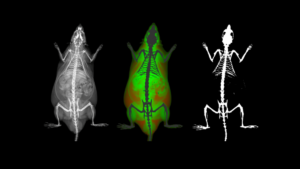Modality Review:
Introduction to MRI for Preclinical Research
When to Consider Using MRI
MRI is considered the gold standard in soft tissue imaging, both in the clinic on patients and by researchers on a wide variety of preclinical imaging subjects. As will be discussed below, MRI relies on endogenous properties of tissue to provide the contrast within the resulting image; there is no use of ionizing radiation which may have harmful effects on the imaging subject and may make longitudinal studies impractical.
MRI as a modality has relatively high spatial resolution, and adequate temporal resolution, and does not suffer from depth of penetration, this allows all soft tissues of the body may be imaged. MRI systems have been designed specifically for use in preclinical research, ranging in size and capabilities to image mice, rats, and rabbits, all the way up to marmosets and other non-human primates. Systems vary in complexity and cost, but newer systems provide significant improvements in ease of citing the instrument as well as in ease of use.
Typically, images are taken either of the whole body, or of a specific anatomical location such as the head to study a specific disease model. Basic anatomical imaging, where image contrast is optimized to highlight disease or pathology, is ideally suited for those studying cancer biology, neurology, specific organs such as the kidney, liver, or lungs, as well as cine imaging used to study cardiac function. Advanced applications, and specific imaging sequences can be used to further elucidate specific anatomical and functional changes, while a variety of contrast agents can be used to study both functional and molecular mechanisms of interest. Whole body imaging is of interest to many researchers, as not only is the anatomical area of interest imaged, but surrounding and seemingly unrelated areas of the body may be imaged showing involvement or continued lack of involvement from other regions of the body.
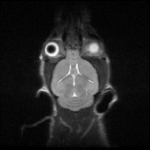
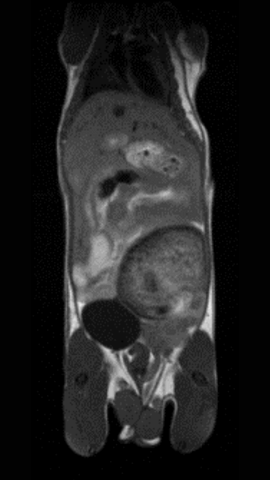

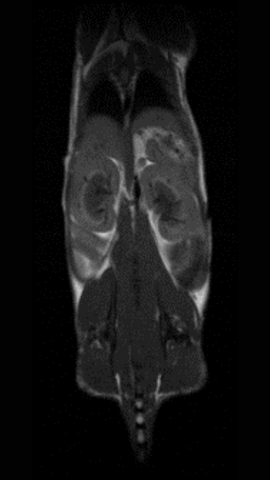
MRI - Multimodal Imaging
MR images provide some of the most exquisite soft tissue contrast, providing ideal anatomical reference images for many other imaging modalities, such as positron emission tomography (PET). In addition to providing an anatomical reference to other modalities, synergistic or complimentary information may be possible by combining various imaging modalities.
One example may be to use PET to confirm the general location of a metastatic lesion, however with the resolution of PET it would not be possible to accurately determine the volume of the lesion. However, without the sensitive PET signal, it would be challenging to locate the small lesion with MRI alone. By combining these complimentary modalities, researchers are better able to detect small lesions, and then quantify their volume at a much earlier stage of disease.
Further, MRI contrast agents may be used to provide additional complimentary information to the overall picture. Contrast agents will be discussed in more detail later in this series, however there are a variety of MR agents available which can be customized and targeted to any number of molecular or cellular targets.
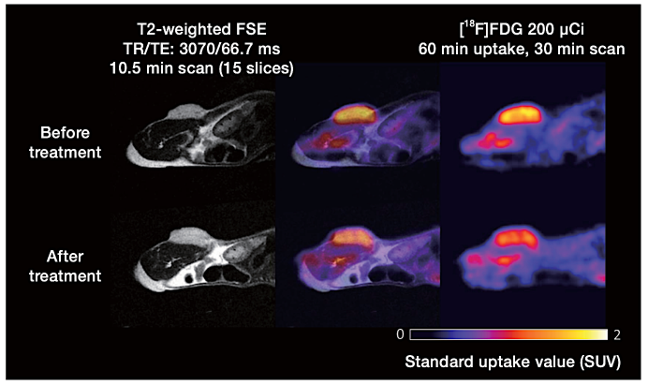
Breaking Down the Barriers to MR Imaging:
Making it Accessible to More Research Groups
Traditional, superconducting, MRI systems pose a challenge to researchers for a variety of reasons; most are large and require significant infrastructure to be installed, such as a separate room with faraday cage, complex set of mechanical components to aid in the cryogen cooling, and a constant supply of electricity, without which the magnet may quench and become permanently disabled. Further, traditional MRI systems are notoriously challenging to operate, often requiring someone with an extensive background in MR physics.
The M-Series compact MRI systems, manufactured by Aspect Imaging and distributed worldwide by Scintica, have been designed specifically to make MRI accessible to more research groups. These systems utilize a permanent magnet, this, at its core, results in a fundamentally easier system to cite, install, and operate, along with significantly reduced cost and complexity to operate. As no electricity is required to create the magnetic field, no means of heat dissipation is required. The M-Series systems are also self-shielded, removing the need for separate rooms with specialized infrastructure to install them. Finally, the acquisition software has been designed for users with minimal knowledge of MRI to operate, and factory default sequences are available to acquire very good images right away. For those that do have a strong background in MR physics, they may dig deeper into the sequence parameters and truly manipulate the settings to acquire specialized images.
The goal of Scintica and the M-Series compact MRI systems is to break down many of the barriers that researchers perceive to be in place when considering MR imaging for their studies. The M-Series is a high-performance MRI system which has been successfully integrated into many labs around the world with no prior MRI experience. The system is so simple to install, that with a single 220V outlet the system has been installed an operated at scientific conferences around the world.
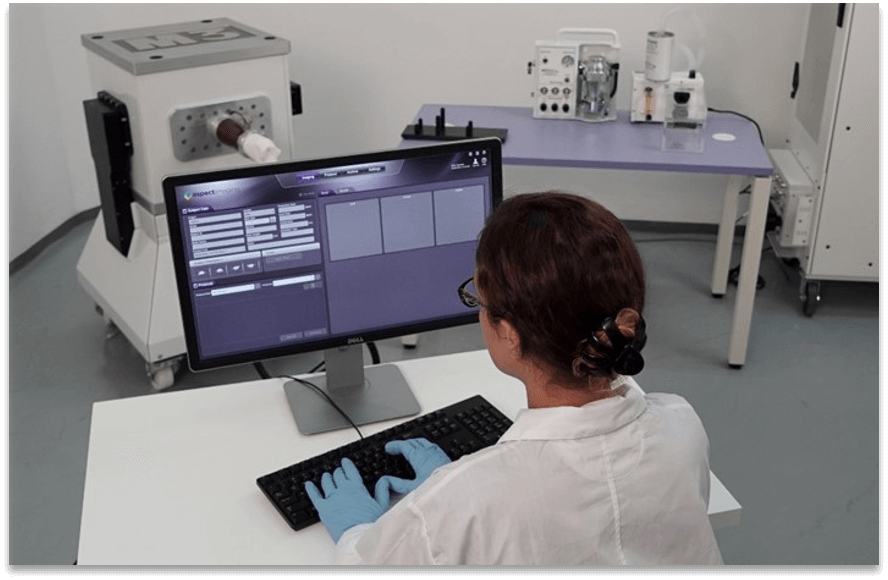
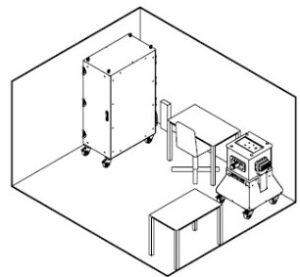
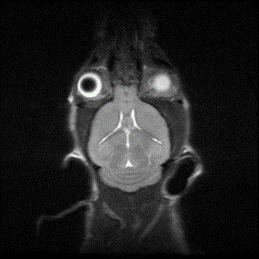

Understanding the Basics of NMR as they relate to MRI
Without diving too deep into the physics of nuclear magnetic resonance (NMR) and magnetic resonance imaging (MRI), there are a few basic principles which will help those just beginning to examine this modality understand what is being imaged and how.
MRI is based on the principles of NMR that were initially discovered back in 1946 independently by two groups, one at Stanford, and the other at Harvard. These groups found that in order to create, and therefore measure, an NMR effect which is the basis of MR imaging, one would need to examine a nucleus which has a non-zero magnetic moment. This occurs naturally for hydrogen (1H), phosphorus (31P), carbon (13C), sodium (23Na), or fluorine (19F). Of note is that in generally when talking MRI this is in reference to 1H imaging; while others are possible, specific hardware and sequences are required. From this point onwards, we will refer to proton imaging when referring to MRI.
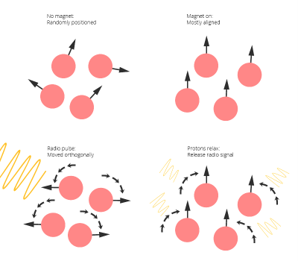
Figure adapted from: James ML, Gambhir SS. Physiological reviews. 2012
In order to take advantage of the non-zero magnetic moment of protons, an external static magnetic field (B0) must be applied. This static magnetic field allows the magnetic moments of the protons to align, also resulting in their precessional movement around the B0 field called the Larmor frequency.
Once aligned with the B0, an additional time-varying magnetic field (B1) is applied by the gradients of the MRI system, this energy is applied perpendicular to the static magnetic field (B0) and this pulse flips the longitudinal magnetization of the proton to the specified angle. The resulting transverse magnetization is not permanent, once the applied B1 is removed, the nuclei will begin to relax back to be in alignment with the B0. There are two independent relaxation processes that take place during this time; first is the spin-lattice relaxation, second is the spin-spin relaxation. The spin-lattice relaxation describes the recovery of the longitudinal magnetization, and relates to the relaxation time T1. While the spin-spin relaxation describes the loss of the coherence in the transverse magnetization vector, and relates to the relaxation time T2. These are the basis for what we will later discuss as T1 and T2 weighted images, this at its most fundamental principle can be thought of as difference in image contrast.
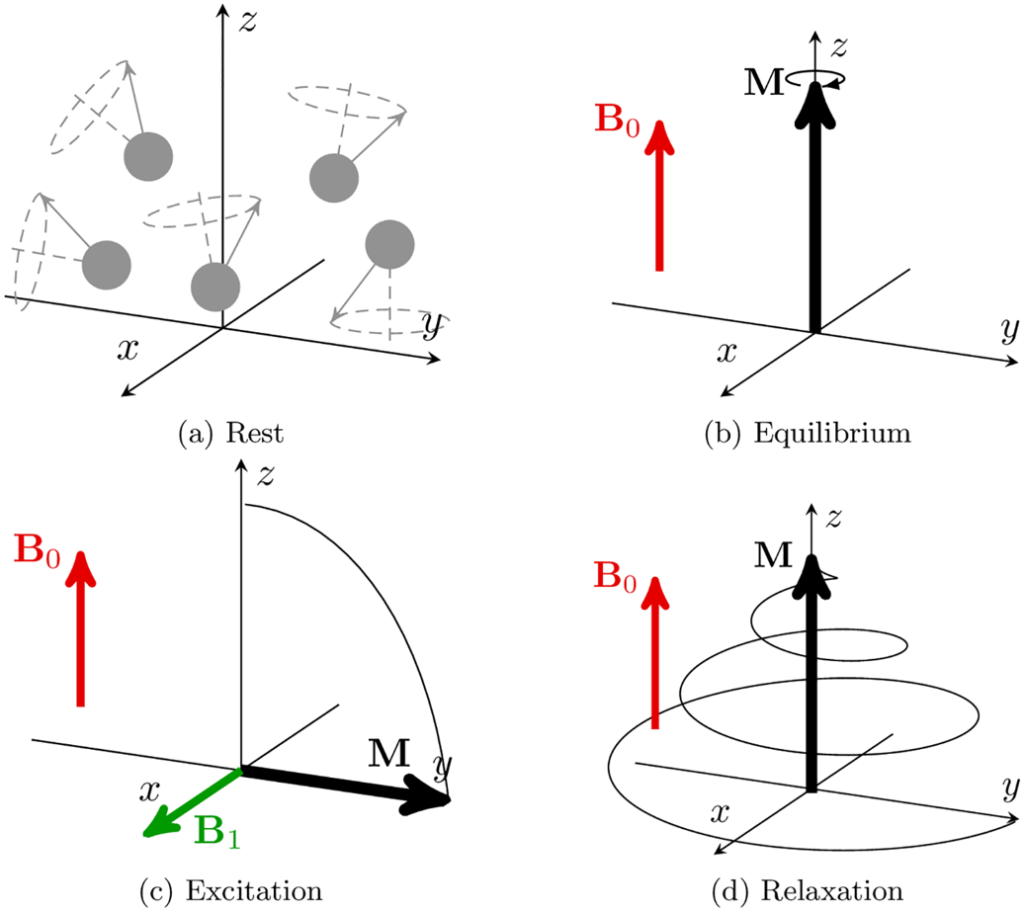
Figure adapted from: James ML, Gambhir SS. Physiological reviews. 2012
In order to create a 2D or 3D image, an MRI system employs additional gradients to produce the spatial encoding in three orthogonal directions to allow for the acquired signals to be located within 2D or 3-Dimensional space. These spatial encoding gradients are a fixture within the system along with the components required to generate the static magnetic field (B0). The imaging coil placed around the subject is responsible for creating the B1 at the prescribed flip angle; additionally, the imaging coils may be the receiver as well, to detect the resulting signal to be converted into the desired image. In some configurations, the excitation and receive coils are physically different components of the system. The imaging coils must be tuned and matched to work optimally within the B0 and with the imaging sample they are placed around.
MRI is considered to be the gold standard, both clinically as well as preclinically, for soft tissue imaging, all without the use of ionizing radiation which may be harmful, and which could prevent the utility of an imaging modality over the course of a longitudinal research study. The researcher will define, or control, the contrast within an MR image based on the sequence selected and the defined parameters; a sequence and its parameters is what defines how the system, gradients, and coils, interact with the protons within the imaging subject. By altering and optimizing the sequence, and associated parameters, the researcher may begin to characterize morphology, physiology, as well as molecular information in vivo. Additionally, contrast agents may be used to further enhance the capabilities of MR imaging to detect additional mechanisms or molecular targets; contrast agent imaging will be discussed later in this series.
Next Modules
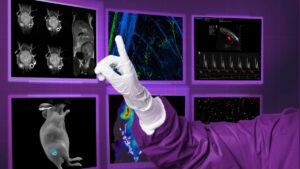
Available Now
Preclinical Imaging Modalities
As we begin to explore the idea of multimodal imaging, let’s first start to explore the variety of preclinical imaging modalities that are most commonly used by researchers around the world.
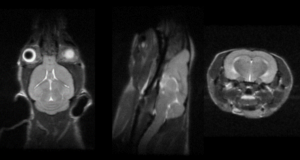
Available Now
Modality: MRI
MRI is considered the gold standard in soft tissue imaging, both in the clinic on patients and by researchers on a wide variety of preclinical imaging subjects.
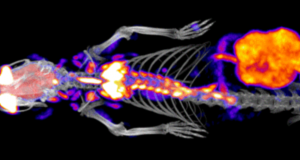
Available Now
Modality: CT
Computed Tomography (CT) is one of the most commonly used clinical imaging techniques, next to perhaps ultrasound.
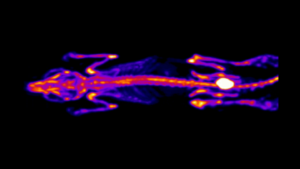
Available Now
Modality: PET
Nuclear imaging modalities include positron emission tomography (PET) as well as single photon emission computed tomography (SPECT), which both detect gamma radiation emitted from a radionucleotide injected into an imaging subject.
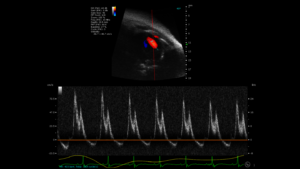
Available Now
Modality: Ultrasound
Ultrasound (US) imaging is one of the most commonly used diagnostic techniques clinically, and is widely used in preclinical imaging as well. It is a safe, non-invasive, and relatively inexpensive technology compared to some of the other available imaging modalities.
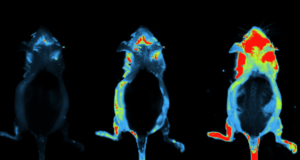
Available Now
Modality: Optical
When discussing Optical Imaging techniques in this series, the meaning is to cover bioluminescence (BLI) and fluorescence (FLI) imaging. T
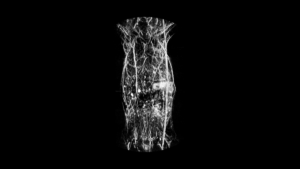
Available Soon
Modality: Photoacoustic
Photoacoustic (PAI) imaging is a technology which combines the sensitivity of optical imaging with the depth of penetration and resolution of ultrasound imaging.
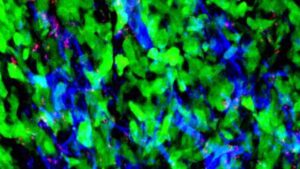
Available Soon
Modality: Microscopy
